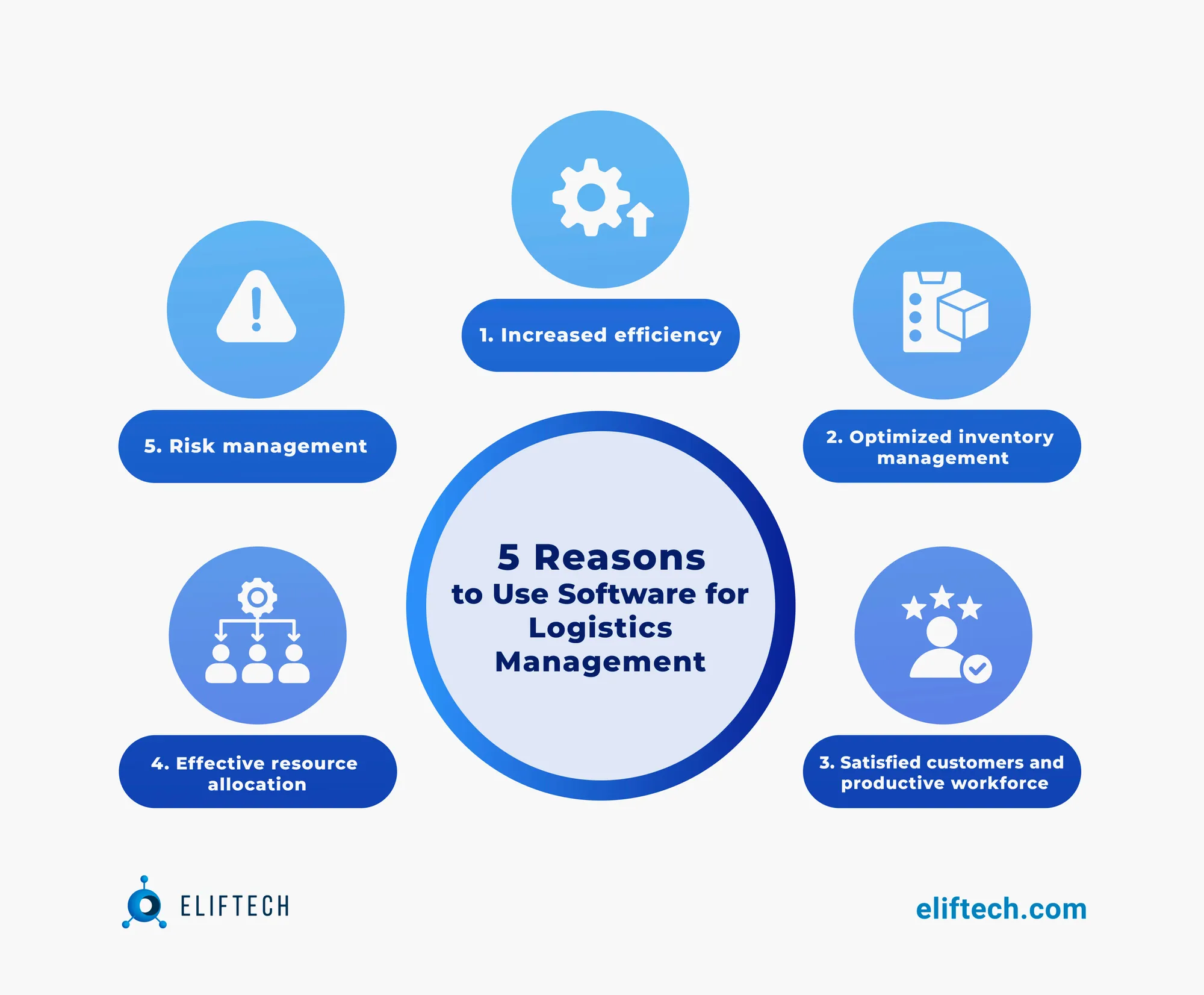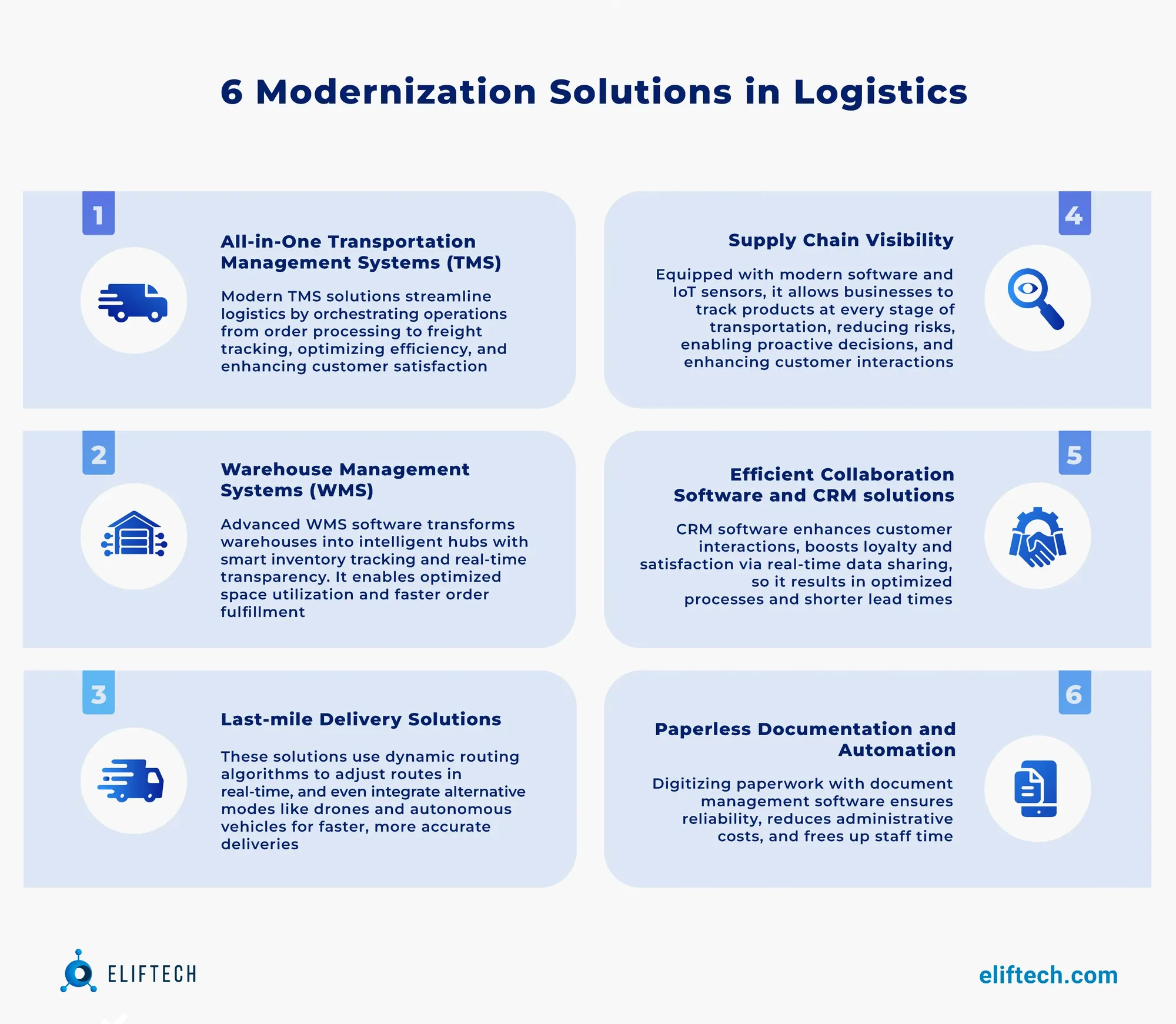Logistics
Full Guide to Digital Transformation in Logistics

In today's fast-paced world, the logistics industry is racing against time. The relentless demand for efficient shipping, precise tracking, and seamless operations has created an urgency like never before. In this digital age, the essence of logistics lies not just in the physical movement of goods but in the speed and accuracy of data.
However, as we delve into this exciting realm, we can't ignore the elephant in the room—the outdated software systems that have long haunted logistics companies. The pain points they cause are numerous, ranging from delays and inefficiencies to mounting customer frustration.
In this blog, we'll explore how digital transformation in logistics is the beacon of hope for overcoming these challenges and revolutionizing the logistics landscape.
Strategies for Digital Transformation in Logistics: Enhancing Logistics Management
Traditional systems fall short when it comes to dealing with the challenges of global markets, changing customer demands, and the need for real-time data visibility. That’s why an increasing number of companies today want to monitor operations in real time, get accurate data, automate tasks, and save money. All of these goals are crucial for them to perform well, solve challenges, and grow, especially when facing tough competition. Modern logistics software can help companies adjust to changes quickly and solve specific problems, ranging from inventory management and route optimization to demand forecasting and risk mitigation.
5 Reasons to Use Software for Logistics Management

Using software to manage logistics is a smart investment that pays off quickly. This is because it helps solve the big problems businesses face today. In particular, 53% need to manage costs wisely, 48% seek solutions to find and keep workers, and 47% aim for better operational efficiency.
Whatever the challenge, using software for logistics management can address these issues simultaneously. Below, we list the top reasons why businesses should consider using software for logistics management to solve their problems and remain competitive in the market.
#1 Increased efficiency
With 47% of third-party logistics (3PL) providers actively looking for efficiency improvements in their logistics operations, it is evident that traditional benchmarks are no longer sufficient. Using new logistics transformation solutions is an innovative and credible way to streamline processes and boost overall efficiency. By integrating modern technologies like AI, ML, IoT, RPA, cloud hosting, and blockchain, logistics management software enables firms to optimize routes, reduce delivery times, and improve resource usage - literally with a snap of the fingers.
One example of a company that has successfully leveraged logistics management software to improve efficiency is DHL. They improved route planning, cut down on delivery times, and boosted operational efficiency by implementing a new cloud-based transportation management system. Thanks to the software's real-time visibility into their supply chain processes, they were able to make data-driven decisions and better manage their resources.
#2 Optimized inventory management
96% of inventory storage and management remain the most common services that 3PL warehouses offer. That’s why improving these essential aspects directly affects a company's bottom line. However, using only traditional methods to manage inventory often ends up in inefficiencies, inaccuracies, and irrational costs.
By integrating software solutions into logistics management, businesses gain a comprehensive tool to effectively address and resolve inventory issues at their source. With real-time visibility into stock levels, demand fluctuations, and order fulfillment, companies can make informed decisions that result in leaner inventory, reduced carrying costs, and improved order accuracy. This not only minimizes the risk of overstocking or stockouts but also enhances customer satisfaction through timely and precise deliveries.
#3 Satisfied customers and productive workforce
As automated systems start tracking orders, shipments, and other critical logistics operations, the risks of human error or inaccuracy decrease. This not only ensures higher customer satisfaction through improved service quality but also contributes to enhanced employee performance and job satisfaction.
The positive impact on both customers and employees has a dual effect on the logistics industry. On the one hand, it leads to better customer retention rates and higher customer satisfaction scores as customers experience improved service and accuracy. On the other hand, it addresses one of the biggest challenges faced by logistics companies - finding and retaining workers.
#4 Effective resource allocation
Logistics software helps businesses allocate resources as efficiently as possible by analyzing inventory, demand, and transportation data. This data-driven strategy reduces waste and optimizes the use of resources, both material and human.
For example, logistics software can help businesses schedule work hours for peak trucking volumes or allocate delivery trucks to maximize their capacity. This simple scenario is just one of many that clearly shows how using the software can help improve resource management, increase productivity, and reduce costs.
#5 Risk management
Many risks revolve around the logistics and supply chain industry, and some of the trickiest ones to anticipate are delays and disruptions. These challenges can lead to serious consequences like missed deadlines, revenue loss, and harm to a company's reputation.
Adopting logistics software that offers real-time visibility into supply chain activity is a successful strategy. This allows businesses to spot potential problems and deal with them before they escalate into major issues.
For example, customers can monitor shipments in real time, monitor traffic and weather, and get alerts about potential delays or problems. Thanks to this proactive approach, businesses can negotiate risks more skillfully and keep up smooth operations.
The Ins and Outs of Modern Logistics Management
The ever-changing supply chain industry pushes modern companies to find new logistics transformation solutions for various problems while keeping their operations strong despite ongoing changes. Recognizing complex elements of logistics management, their logic, dependencies, and limitations is the first step toward smart optimization.
The Current Logistics Processes and Their Shortcomings
Current logistics processes include several related tasks that are necessary to transport goods from one place to another efficiently. These processes may vary depending on the company's specific industry, transportation route, and supply chain structure.
General logistics typically include transportation, warehousing, inventory management, order fulfillment, and documentation. Unfortunately, they often come with associated shortcomings that make it challenging for businesses to optimize their operations and meet customer expectations. These shortcomings can hinder efficiency, cause delays, increase costs, and impact overall customer satisfaction. Below, we describe the main of them.
Fragmented communication
A logistics supply chain starts with the manufacturing process and ends with the delivery of the final product to the customer. Effective communication between stakeholders, such as manufacturers, distributors, and suppliers, ensures smooth and efficient operations. However, the lack of efficient communication channels among these stakeholders can lead to miscommunication, causing delays, mistakes, and inefficiencies.
Manual tasks and inefficiencies
The logistics process suffers from manual data entry, paperwork, and repetitive operations, which raise processing times and error rates and slow down operational speed and accuracy. That’s where IT transformation for transportation & logistics can show its powerful capabilities.
Lack of real-time visibility of shipments
Modern consumers expect visibility of their orders. However, when these customers can't see where things are or what's happening in real time, it makes it hard for businesses to make quick decisions and respond to demand changes. This lack of visibility throughout the logistics process hampers timely decision-making and can lead to warehouse operational inefficiencies.
Disruption vulnerability
Logistics operations are vulnerable to unpredictable events, such as weather-related disruptions or sudden surges in demand, which can pose significant risks. These unforeseen circumstances often lead to delays, escalated costs, and customer dissatisfaction.
Delivery delays
The pandemic forced factories to close, causing a shortage of workers and creating various issues. Additionally, outdated and disjointed processes have negatively affected delivery times. As a result, many brands are experiencing delays in their product launches, which, in turn, leads to longer waiting times for customers to receive their shipments.
Filling the Gaps with Custom Software Development for Logistics
In response to these challenges, some businesses may consider application migration the right and quick solution. However, it's important to understand that migration may not be sufficient to handle the complex problems in the logistics sector. These solutions may not offer the adaptability and customization that companies need to streamline their processes and satisfy their particular needs.
Custom software development emerges as a powerful approach to tackle the abovementioned issues comprehensively, offering tailored solutions to modernize logistics management.
Automation for efficiency
Technology reduces human efforts to perform manual and repetitive tasks. Custom software can bring the required automation to processes businesses spend much time to improve operational efficiency and reduce human intervention and possible errors.
Real-time analytics for informed decisions
Custom software provides businesses with real-time insights. This is made possible through customized data analytics and reporting tools integrated into the software system. These systems collect and analyze real-time data from a variety of sources, including sales data, inventory levels, consumer preferences, and market trends. By leveraging this real-time information, businesses can gain valuable insights into their operations, predict demand, optimize routes, and manage inventory more effectively.
Predictive analytics for risk mitigation
Incorporating predictive analytics into custom software equips logistics companies with the ability to forecast potential disruptions. Custom software's predictive ability can spot a variety of possible disruptions. For instance, it can foresee shifts in demand, regional weather-related disturbances, or delays in the transit of freight. In turn, businesses can make necessary adjustments to their plans using this knowledge, such as rerouting shipments through alternate channels, modifying inventory levels, or communicating issues with customers early on.
Unified logistics platforms
Custom software can easily fill communication gaps by creating integrated platforms that connect all logistics process participants. This ensures real-time communication, seamless collaboration, and reduced misunderstanding and delays. With everyone on the same page, from suppliers to customers, the logistics journey becomes smoother, faster, and more efficient.
Enhanced customer experience
Custom software lets logistics businesses offer consumers personalized communication, real-time tracking, and accurate delivery estimates. The level of transparency and engagement promotes confidence, customer satisfaction, and long-lasting connections between the logistics company and its customers.
Did you know ElifTech can help you streamline and automate any challenging logistics processes?
Contact our team for a consultation about logistic system modernization, processing software revamping, and implementation of automation solutions—or describe your needs for more optimal suggestions.
What Software and Processes Can Be Modernized in Logistics?

We've previously discussed that logistics processes include transportation, warehousing, inventory management, order fulfillment, and documentation. However, even if these processes already have supporting software, there's always room for improvement through a logistics modernization program.
Here's how proper digital transformation in logistics and supply chain works:
All-in-One Transportation Management Systems (TMS)
Beyond traditional logistics, the realm of transportation management has evolved significantly. TMS software now consists of a spectrum of operations, from order processing and route optimization to freight tracking and carrier selection. Modern TMS solutions serve as powerful orchestrators, efficiently coordinating the various elements within the digital supply chain logistics transformation to optimize efficiency, cost-effectiveness, and customer satisfaction.
One well-known example is Oracle Transportation Management (OTM) which provides a comprehensive platform that manages both third-party shipping and in-house delivery fleets. It supports multi-modal and multi-leg shipping, with integrations to numerous carriers.
Warehouse Management Systems (WMS)
Warehouse operations are the foundation of effective inventory management. Modernizing with advanced WMS software transforms warehouses into intelligent hubs. With features such as smart inventory tracking, automatic picking and packaging, and real-time transparency, businesses can optimize space utilization, minimize errors, and speed up order fulfillment.
Dive into the topic: Building 3PL Warehouse Management Software: Types, Elements, Cost, Setup
Last-mile Delivery Solutions
Last-mile delivery is a critical aspect of logistics, as this is the final leg of delivery. However, despite this being the final step in the delivery process, it presents unique challenges, such as numerous logistic issues, frequent stops, increased demand in urban areas, returns and failed deliveries, products that need specific handling, etc.
Modern logistics transformation solutions take full responsibility for efficiently managing and tackling these issues. They use dynamic routing algorithms to adjust delivery routes in real time, considering factors like traffic, weather, delivery windows, and even the locations of multiple stops on the same route. Furthermore, integrating alternative modes like drones and autonomous vehicles is revolutionizing last-mile logistics. These innovations promise faster delivery times and improved accuracy, even in congested urban environments.
Supply Chain Visibility
Thanks to comprehensive supply chain visibility, modern software makes it possible to track products at every stage of their transportation. For example, by integrating IoT sensors, businesses can learn more about the current state of their products, the environment, and any bottlenecks. This improved visibility helps decrease risks, proactive decision-making, and timely interaction with customers.
Efficient Collaboration Software and CRM Solutions
As a result of modernization, the way organizations work with their supply chain partners is also changing. Real-time data sharing is made possible by cloud-based collaboration tools, enabling seamless coordination between stakeholders. Processes can be jointly optimized by suppliers, manufacturers, distributors, and retailers. As a result, lead times can be cut down, and all participants can react swiftly to any possible changes.
Modernization also helps streamline the way companies interact with their customers. Modern CRM software helps logistics businesses manage client interactions, track queries, and offer individualized services, improving customer loyalty and satisfaction.
Paperless Documentation and Automation
Traditional documentation methods often come with a range of challenges, as they are prone to errors and are time-consuming. However, the digitalization of paperwork with document management software offers a revolutionary answer. Businesses can guarantee the reliability of their documents and experience the full advantages of logistics software from simple, quick information access. Using document management software also greatly reduces administrative costs and frees up staff time for more important tasks.
Additionally, workflow automation speeds up operations while also streamlining the approval process and reducing bottlenecks. As a result, the organization becomes more effective, more productive, and more collaborative.
Smart Modernization with ElifTech: Custom Software for Logistics Management
With business environments undergoing rapid and constant changes, fueled by global events and escalating customer demands, it has become imperative for businesses to step into digital transformation in transportation and logistics. Without doing so, firms risk slipping behind competitors and missing out on chances for innovation and growth.
When it's time to figure out what logistics transformation solutions can solve the problems your company faces, it can be tricky. Different types of software have their advantages and limitations, making it tough to know which one will truly work well for your company, especially in the long run.
However, custom software development as a part of digital transformation in the logistics industry can be the answer to eliminate this hesitation. Unlike ready-made software, custom solutions are made just for your company. They take into account your unique processes, needs, and challenges. This special approach makes things work better, faster, and more accurately. Plus, custom software can change as your business changes, which is perfect for the ever-changing logistics world that businesses deal with today.
As a reputable logistics software development company, the ElifTech team has enough expertise and industry-specific knowledge of best practices and technologies needed to support logistics digital transformation for businesses in their needs to build:
1. Warehouse & Inventory Management Solution
- Streamline warehouse reporting, dashboard & analytics
- Ensure inventory visibility, tracking & management
2. Transportation Management Solution
- Enhance time efficiency with AI calculations
- Optimize costs with enhanced (route) analytics
- Optimize route planning
3. Costs Management Solution
- Automate billing
- Track costs for units
- Develop product pricing strategies
4. Order / Delivery Management Solution
- Order process tracking
- Vehicle tracking
- Transparent communications with clients
- Fasten order fulfillment
5. Staff Management Solution
- Fasten decision-making
- Manage tasks automatically
- Reduce manual work
- Advanced reporting on productivity
6. Reporting Management Solution
- Automated reports
- Advanced analytics
- Inventory and order volume reports
- Labor hours reporting
- Productivity dashboards
Do your challenges align with the solutions we provide? Let us know about your next project, and our team will consult you on all possible solutions for efficient digital transformation in logistics.
